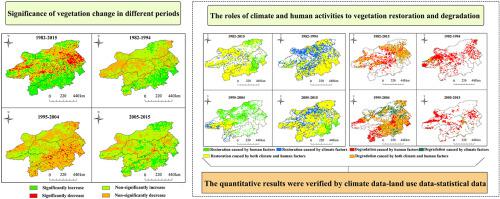当前位置:
X-MOL 学术
›
Ecol. Eng.
›
论文详情
Our official English website, www.x-mol.net, welcomes your feedback! (Note: you will need to create a separate account there.)
Insights on the roles of climate and human activities to vegetation degradation and restoration in Beijing-Tianjin sandstorm source region
Ecological Engineering ( IF 3.8 ) Pub Date : 2021-01-01 , DOI: 10.1016/j.ecoleng.2020.106105 Lu Yu , Zhitao Wu , Ziqiang Du , Hong Zhang , Yong Liu
Ecological Engineering ( IF 3.8 ) Pub Date : 2021-01-01 , DOI: 10.1016/j.ecoleng.2020.106105 Lu Yu , Zhitao Wu , Ziqiang Du , Hong Zhang , Yong Liu

|
Abstract Evaluating climate and human-induced vegetation change could support managing the sustainability of ecological environment. Based on the Normalized Difference Vegetation Index (NDVI) dataset, meteorological data (temperature, precipitation), land use data and statistical data, this study used a trend quantitative analysis to distinguish the relative roles of climate change and human activities on vegetation degradation and restoration from 1982 to 2015 in Beijing-Tianjin sandstorm source region. Our results demonstrated that the increased vegetation reached 63.8% of the study area during 1982–2015. Using piecewise linear regression method, we identified two turning points within the period 1982–2015 were 1994 and 2004, respectively. By considering the turning points, we found the increasing, decreasing, and increasing trend during 1982–1994, 1995–2004 and 2005–2015, respectively. In 1982–2015, 68.1% of the vegetation change was dominated by the combined effects of climate and human activities, whereas 25.4% was caused by human activities. During 1982–1994, the increasing trend of vegetation was due to favorable climate factors (26.8%) and the combined effects of both (45.4%). In 1995–2004, the vegetation degradation was driven by unreasonable human activities (13%) and the combined effects of unfavorable climate factors and unreasonable human activities (33.1%). However, with the implementation of ecological engineering, the positive human activities (8%) and the combined effects of both (59.1%) were responsible for vegetation restoration during 2005–2015. We noticed that precipitation was the main climate factor limiting regional vegetation change, the sensitivity of vegetation to precipitation was increasing over the study period. Nevertheless, human activities played an increasingly important role in regional vegetation. In particularly, the ecological engineering and increasing precipitation were the main factors for regional vegetation restoration in the past 10 years.
中文翻译:

气候和人类活动对京津沙尘暴源区植被退化与恢复作用的洞察
摘要 评估气候和人为引起的植被变化可以支持管理生态环境的可持续性。本研究基于归一化差异植被指数(NDVI)数据集、气象数据(温度、降水)、土地利用数据和统计数据,采用趋势定量分析区分气候变化和人类活动对植被退化和恢复的相对作用1982-2015年京津沙尘暴源区. 我们的结果表明,在 1982-2015 年期间,增加的植被达到了研究区域的 63.8%。使用分段线性回归方法,我们确定了 1982-2015 年期间的两个转折点,分别是 1994 年和 2004 年。通过考虑转折点,我们发现增加、减少、1982-1994 年、1995-2004 年和 2005-2015 年分别呈上升趋势。1982-2015年,68.1%的植被变化是由气候和人类活动共同作用引起的,而25.4%是由人类活动引起的。1982-1994 年间,植被增加的趋势是由于有利的气候因素(26.8%)和两者的共同作用(45.4%)。1995-2004年,不合理的人类活动(13%)和不利气候因素和不合理的人类活动共同作用(33.1%)导致植被退化。然而,随着生态工程的实施,2005-2015 年的植被恢复是由积极的人类活动(8%)和两者共同作用(59.1%)造成的。我们注意到降水是限制区域植被变化的主要气候因素,植被对降水的敏感性在研究期间不断增加。尽管如此,人类活动在区域植被中发挥着越来越重要的作用。特别是生态工程和降水增加是近10年来区域植被恢复的主要因素。
更新日期:2021-01-01
中文翻译:

气候和人类活动对京津沙尘暴源区植被退化与恢复作用的洞察
摘要 评估气候和人为引起的植被变化可以支持管理生态环境的可持续性。本研究基于归一化差异植被指数(NDVI)数据集、气象数据(温度、降水)、土地利用数据和统计数据,采用趋势定量分析区分气候变化和人类活动对植被退化和恢复的相对作用1982-2015年京津沙尘暴源区. 我们的结果表明,在 1982-2015 年期间,增加的植被达到了研究区域的 63.8%。使用分段线性回归方法,我们确定了 1982-2015 年期间的两个转折点,分别是 1994 年和 2004 年。通过考虑转折点,我们发现增加、减少、1982-1994 年、1995-2004 年和 2005-2015 年分别呈上升趋势。1982-2015年,68.1%的植被变化是由气候和人类活动共同作用引起的,而25.4%是由人类活动引起的。1982-1994 年间,植被增加的趋势是由于有利的气候因素(26.8%)和两者的共同作用(45.4%)。1995-2004年,不合理的人类活动(13%)和不利气候因素和不合理的人类活动共同作用(33.1%)导致植被退化。然而,随着生态工程的实施,2005-2015 年的植被恢复是由积极的人类活动(8%)和两者共同作用(59.1%)造成的。我们注意到降水是限制区域植被变化的主要气候因素,植被对降水的敏感性在研究期间不断增加。尽管如此,人类活动在区域植被中发挥着越来越重要的作用。特别是生态工程和降水增加是近10年来区域植被恢复的主要因素。



























 京公网安备 11010802027423号
京公网安备 11010802027423号